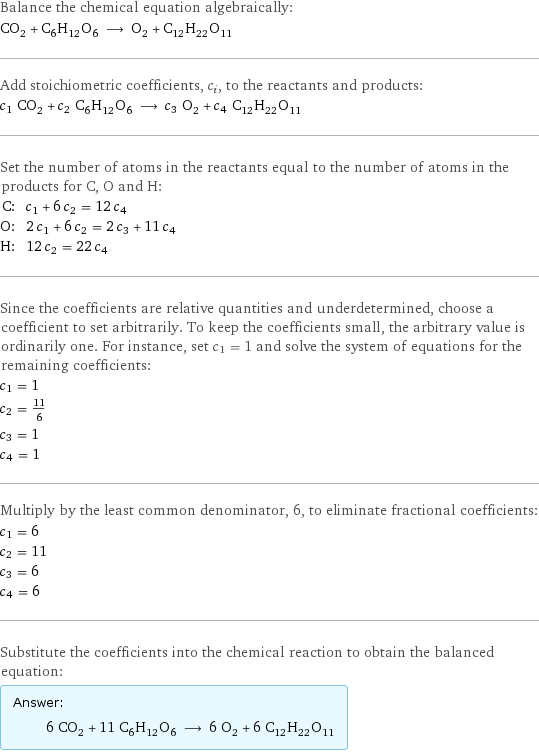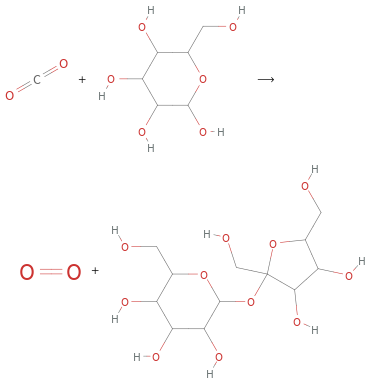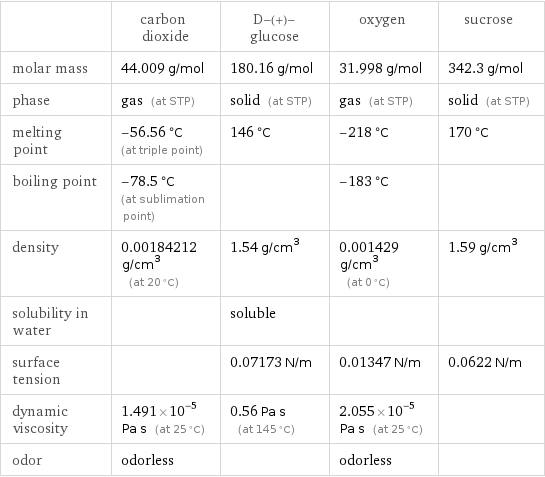Input interpretation

CO_2 carbon dioxide + C_6H_12O_6 D-(+)-glucose ⟶ O_2 oxygen + C_12H_22O_11 sucrose
Balanced equation

Balance the chemical equation algebraically: CO_2 + C_6H_12O_6 ⟶ O_2 + C_12H_22O_11 Add stoichiometric coefficients, c_i, to the reactants and products: c_1 CO_2 + c_2 C_6H_12O_6 ⟶ c_3 O_2 + c_4 C_12H_22O_11 Set the number of atoms in the reactants equal to the number of atoms in the products for C, O and H: C: | c_1 + 6 c_2 = 12 c_4 O: | 2 c_1 + 6 c_2 = 2 c_3 + 11 c_4 H: | 12 c_2 = 22 c_4 Since the coefficients are relative quantities and underdetermined, choose a coefficient to set arbitrarily. To keep the coefficients small, the arbitrary value is ordinarily one. For instance, set c_1 = 1 and solve the system of equations for the remaining coefficients: c_1 = 1 c_2 = 11/6 c_3 = 1 c_4 = 1 Multiply by the least common denominator, 6, to eliminate fractional coefficients: c_1 = 6 c_2 = 11 c_3 = 6 c_4 = 6 Substitute the coefficients into the chemical reaction to obtain the balanced equation: Answer: | | 6 CO_2 + 11 C_6H_12O_6 ⟶ 6 O_2 + 6 C_12H_22O_11
Structures

+ ⟶ +
Names

carbon dioxide + D-(+)-glucose ⟶ oxygen + sucrose
Equilibrium constant
![Construct the equilibrium constant, K, expression for: CO_2 + C_6H_12O_6 ⟶ O_2 + C_12H_22O_11 Plan: • Balance the chemical equation. • Determine the stoichiometric numbers. • Assemble the activity expression for each chemical species. • Use the activity expressions to build the equilibrium constant expression. Write the balanced chemical equation: 6 CO_2 + 11 C_6H_12O_6 ⟶ 6 O_2 + 6 C_12H_22O_11 Assign stoichiometric numbers, ν_i, using the stoichiometric coefficients, c_i, from the balanced chemical equation in the following manner: ν_i = -c_i for reactants and ν_i = c_i for products: chemical species | c_i | ν_i CO_2 | 6 | -6 C_6H_12O_6 | 11 | -11 O_2 | 6 | 6 C_12H_22O_11 | 6 | 6 Assemble the activity expressions accounting for the state of matter and ν_i: chemical species | c_i | ν_i | activity expression CO_2 | 6 | -6 | ([CO2])^(-6) C_6H_12O_6 | 11 | -11 | ([C6H12O6])^(-11) O_2 | 6 | 6 | ([O2])^6 C_12H_22O_11 | 6 | 6 | ([C12H22O11])^6 The equilibrium constant symbol in the concentration basis is: K_c Mulitply the activity expressions to arrive at the K_c expression: Answer: | | K_c = ([CO2])^(-6) ([C6H12O6])^(-11) ([O2])^6 ([C12H22O11])^6 = (([O2])^6 ([C12H22O11])^6)/(([CO2])^6 ([C6H12O6])^11)](../image_source/aa4a6187631e991095bba624087caa35.png)
Construct the equilibrium constant, K, expression for: CO_2 + C_6H_12O_6 ⟶ O_2 + C_12H_22O_11 Plan: • Balance the chemical equation. • Determine the stoichiometric numbers. • Assemble the activity expression for each chemical species. • Use the activity expressions to build the equilibrium constant expression. Write the balanced chemical equation: 6 CO_2 + 11 C_6H_12O_6 ⟶ 6 O_2 + 6 C_12H_22O_11 Assign stoichiometric numbers, ν_i, using the stoichiometric coefficients, c_i, from the balanced chemical equation in the following manner: ν_i = -c_i for reactants and ν_i = c_i for products: chemical species | c_i | ν_i CO_2 | 6 | -6 C_6H_12O_6 | 11 | -11 O_2 | 6 | 6 C_12H_22O_11 | 6 | 6 Assemble the activity expressions accounting for the state of matter and ν_i: chemical species | c_i | ν_i | activity expression CO_2 | 6 | -6 | ([CO2])^(-6) C_6H_12O_6 | 11 | -11 | ([C6H12O6])^(-11) O_2 | 6 | 6 | ([O2])^6 C_12H_22O_11 | 6 | 6 | ([C12H22O11])^6 The equilibrium constant symbol in the concentration basis is: K_c Mulitply the activity expressions to arrive at the K_c expression: Answer: | | K_c = ([CO2])^(-6) ([C6H12O6])^(-11) ([O2])^6 ([C12H22O11])^6 = (([O2])^6 ([C12H22O11])^6)/(([CO2])^6 ([C6H12O6])^11)
Rate of reaction
![Construct the rate of reaction expression for: CO_2 + C_6H_12O_6 ⟶ O_2 + C_12H_22O_11 Plan: • Balance the chemical equation. • Determine the stoichiometric numbers. • Assemble the rate term for each chemical species. • Write the rate of reaction expression. Write the balanced chemical equation: 6 CO_2 + 11 C_6H_12O_6 ⟶ 6 O_2 + 6 C_12H_22O_11 Assign stoichiometric numbers, ν_i, using the stoichiometric coefficients, c_i, from the balanced chemical equation in the following manner: ν_i = -c_i for reactants and ν_i = c_i for products: chemical species | c_i | ν_i CO_2 | 6 | -6 C_6H_12O_6 | 11 | -11 O_2 | 6 | 6 C_12H_22O_11 | 6 | 6 The rate term for each chemical species, B_i, is 1/ν_i(Δ[B_i])/(Δt) where [B_i] is the amount concentration and t is time: chemical species | c_i | ν_i | rate term CO_2 | 6 | -6 | -1/6 (Δ[CO2])/(Δt) C_6H_12O_6 | 11 | -11 | -1/11 (Δ[C6H12O6])/(Δt) O_2 | 6 | 6 | 1/6 (Δ[O2])/(Δt) C_12H_22O_11 | 6 | 6 | 1/6 (Δ[C12H22O11])/(Δt) (for infinitesimal rate of change, replace Δ with d) Set the rate terms equal to each other to arrive at the rate expression: Answer: | | rate = -1/6 (Δ[CO2])/(Δt) = -1/11 (Δ[C6H12O6])/(Δt) = 1/6 (Δ[O2])/(Δt) = 1/6 (Δ[C12H22O11])/(Δt) (assuming constant volume and no accumulation of intermediates or side products)](../image_source/8d6708a1a02e9aed0ddbff0ae65c0912.png)
Construct the rate of reaction expression for: CO_2 + C_6H_12O_6 ⟶ O_2 + C_12H_22O_11 Plan: • Balance the chemical equation. • Determine the stoichiometric numbers. • Assemble the rate term for each chemical species. • Write the rate of reaction expression. Write the balanced chemical equation: 6 CO_2 + 11 C_6H_12O_6 ⟶ 6 O_2 + 6 C_12H_22O_11 Assign stoichiometric numbers, ν_i, using the stoichiometric coefficients, c_i, from the balanced chemical equation in the following manner: ν_i = -c_i for reactants and ν_i = c_i for products: chemical species | c_i | ν_i CO_2 | 6 | -6 C_6H_12O_6 | 11 | -11 O_2 | 6 | 6 C_12H_22O_11 | 6 | 6 The rate term for each chemical species, B_i, is 1/ν_i(Δ[B_i])/(Δt) where [B_i] is the amount concentration and t is time: chemical species | c_i | ν_i | rate term CO_2 | 6 | -6 | -1/6 (Δ[CO2])/(Δt) C_6H_12O_6 | 11 | -11 | -1/11 (Δ[C6H12O6])/(Δt) O_2 | 6 | 6 | 1/6 (Δ[O2])/(Δt) C_12H_22O_11 | 6 | 6 | 1/6 (Δ[C12H22O11])/(Δt) (for infinitesimal rate of change, replace Δ with d) Set the rate terms equal to each other to arrive at the rate expression: Answer: | | rate = -1/6 (Δ[CO2])/(Δt) = -1/11 (Δ[C6H12O6])/(Δt) = 1/6 (Δ[O2])/(Δt) = 1/6 (Δ[C12H22O11])/(Δt) (assuming constant volume and no accumulation of intermediates or side products)
Chemical names and formulas
![| carbon dioxide | D-(+)-glucose | oxygen | sucrose formula | CO_2 | C_6H_12O_6 | O_2 | C_12H_22O_11 name | carbon dioxide | D-(+)-glucose | oxygen | sucrose IUPAC name | carbon dioxide | 6-(hydroxymethyl)oxane-2, 3, 4, 5-tetrol | molecular oxygen | (2R, 3S, 4S, 5S, 6R)-2-[(2S, 3S, 4S, 5R)-3, 4-dihydroxy-2, 5-bis(hydroxymethyl)oxolan-2-yl]oxy-6-(hydroxymethyl)oxane-3, 4, 5-triol](../image_source/feab676ff0992fc404921af3604ab230.png)
| carbon dioxide | D-(+)-glucose | oxygen | sucrose formula | CO_2 | C_6H_12O_6 | O_2 | C_12H_22O_11 name | carbon dioxide | D-(+)-glucose | oxygen | sucrose IUPAC name | carbon dioxide | 6-(hydroxymethyl)oxane-2, 3, 4, 5-tetrol | molecular oxygen | (2R, 3S, 4S, 5S, 6R)-2-[(2S, 3S, 4S, 5R)-3, 4-dihydroxy-2, 5-bis(hydroxymethyl)oxolan-2-yl]oxy-6-(hydroxymethyl)oxane-3, 4, 5-triol
Substance properties

| carbon dioxide | D-(+)-glucose | oxygen | sucrose molar mass | 44.009 g/mol | 180.16 g/mol | 31.998 g/mol | 342.3 g/mol phase | gas (at STP) | solid (at STP) | gas (at STP) | solid (at STP) melting point | -56.56 °C (at triple point) | 146 °C | -218 °C | 170 °C boiling point | -78.5 °C (at sublimation point) | | -183 °C | density | 0.00184212 g/cm^3 (at 20 °C) | 1.54 g/cm^3 | 0.001429 g/cm^3 (at 0 °C) | 1.59 g/cm^3 solubility in water | | soluble | | surface tension | | 0.07173 N/m | 0.01347 N/m | 0.0622 N/m dynamic viscosity | 1.491×10^-5 Pa s (at 25 °C) | 0.56 Pa s (at 145 °C) | 2.055×10^-5 Pa s (at 25 °C) | odor | odorless | | odorless |
Units
